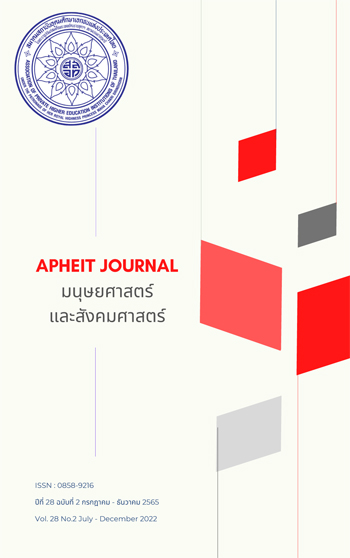An Analysis of Creative Tourism Activities Affecting the Satisfaction and Loyalty of Thai Tourists: A Case Study of Ban Laem Sub-district Community, Suphan Buri
คำสำคัญ:
Creative tourism, Creative tourism activities, Loyaltyบทคัดย่อ
The objectives of this research were study 1) the experiences of Thai tourists from their participation in the creative tourism activities, 2) Thai tourists’ satisfaction in participating in the creative tourism activities, 3) the influence of the experiences gained from participating in creative tourism activities, and 4) the influence of Thai tourists' satisfaction affecting the loyalty of the Thai tourists. This study employed a quantitative research method. The data were collected by questionnaires from 351 Thai tourists. The result of a multiple regression analysis of experiences in participating in the creative tourism activities affecting the satisfaction of the Thai tourists found that experiences affected the satisfaction of the Thai tourists. As for the results of a multiple regression analysis of experiences affecting the loyalty of Thai tourists found that experiences affected the loyalty of Thai tourists. And finally, the results of a multiple regression analysis of satisfaction affecting tourists’ loyalty showed that satisfaction with creative tourism activities significantly affected their loyalty.
References
กระทรวงการท่องเที่ยวและกีฬา.(2563). "รมต.พิพัฒน์"ดัน"อพท."ผนึกเครือข่ายรับท่องเที่ยววิถีชีวิตใหม่
ผุดโปรแกรมทัวร์สัมผัสชุมชน 81 แห่ง เจาะตลาดคุณภาพ. สืบค้นเมื่อ 4 พฤศจิกายน 2563,จาก
https://www.mots.go.th/News-view.php?nid=12919
กองเศรษฐกิจการท่องเที่ยวและกีฬา.(2563). COVID-19 กับผลกระทบต่อการท่องเที่ยวไทย. สืบค้นเมื่อ 3
พฤศจิกายน 2563, จาก https://www.mots.go.th/download/TourismEconomicReport/4- 1TourismEconomicVol4.pdf
จักรวาล วงศ์มณี และรักษ์พงศ์ วงศาโรจน์. (2564). คุณลักษณะการท่องเที่ยวเชิงสร้างสรรค์ที่นักท่องเที่ยว คาดหวังในแหล่งจุดหมายปลายทางเชิงสร้างสรรค์ในประเทศไทย.วารสารสันติศึกษาปริทรรศน์ มจร,
(6), 2665-2678.
จินต์ประวีร์ เจริญฉิม และสิริชัย ดีเลิศ. (2563). กระบวนการถ่ายทอดภูมิปัญญาของผู้สูงอายุสู่ชุมชนและสังคม ที่ยั่งยืน. วารสารปาริชาต มหาวิทยาลัยทักษิณ, 33(2), 152-167.
ณัฏฐพัชร มณีโรจน์. (2560). การจัดการการท่องเที่ยวโดยชุมชน. วารสารวิชาการการท่องเที่ยวไทย นานาชาติ, 13(2), 25-46.
บุญเลิศ จิตตั้งวัฒนา (2555). พฤติกรรมนักท่องเที่ยว (พิมพ์ครั้งที่ 1). กรุงเทพฯ : เฟริ์นข้าหลวง พริ้นติ้ง แอนด์พับลิชชิ่ง.
ปิยพงศ์ เขตปิยรัตน (2564). ประสบการณ์การท่องเที่ยวที่ส่งผลต่อความพึงพอใจของนักท่องเที่ยวชาวไทยใน การมาท่องเที่ยวฟาร์มสเตย์ในจังหวัดนครราชสีมา. วารสารการบริหารการปกครองและนวัตกรรม ท้องถิ่น, 5(2), 61-74.
เลิศพร ภาระสกุล. (2556). พฤติกรรมนักท่องเที่ยว (พิมพ์ครั้งที่ 2). กรุงเทพฯ: จุฬาลงกรณ์มหาวิทยาลัย.วิสาหกิจชุมชนท่องเที่ยววิถีชุมชนตาบลบ้านแหลม. (2562) รายงานข้อมูลนักท่องเที่ยว(เอกสารไม่ตีพิมพ์). สุพรรณบุรี : ฝ่ายการตลาดและประชาสัมพันธ์กลุ่มวิสาหกิจชุมชน ท่องเที่ยววิถีชุมชนตำบลบ้านแหลม.
สุดแดน วิสุทธิลักษณ์ และคณะ. (2556). การท่องเที่ยวเชิงสร้างสรรค์ (Creative Tourism Thailand).กรุงเทพฯ: องค์การบริหารการพัฒนาพื้นที่พิเศษเพื่อการท่องเที่ยวอย่างยั่งยืน (องค์การมหาชน).
อารีรัตน์ วัชรโยธินกุล. (2560). ความคาดหวังและมิติความพึงพอใจของนักท่องเที่ยวชาวต่างชาติที่ส่งผลต่อการกลับมาเยือนซ้ำเกาะล้านจังหวัดชลบุรี (วิทยานิพนธ์ปริญญามหาบัณฑิต, มหาวิทยาลัยธุรกิจบัณฑิตย์).
อิษฎาภรณ์ พิรัชต์ชัยกุล และอัศวิน แสงพิกุล. (2563). ประสบการณ์การท่องเที่ยวแหล่งท่องเที่ยวเชิงสุขภาพ
ประเภทบ่อน้ำพุร้อน ที่ส่งผลต่อความพึงพอใจของนักท่องเที่ยวชาวไทย ในอำเภอทองผาภูมิจังหวัด
กาญจนบุรี. วารสารวิชาการ มหาวิทยาลัยราชภัฏกาญจนบุรี, 10(2), 223-234.
Ali, F., Ryu, K., & Hussain, K. (2015). Influence of Experiences on Memories Satisfaction and Behavioral Intentions: A Study of Creative Tourism, Journal of Travel & Tourism Marketing, 33(1), 85-100.
Chen, H., & Rahman, I. (2018). Cultural tourism: An analysis of engagement, cultural contact, memorable tourism experience and destination loyalty. Tourism Management Perspectives, 26(September), 153–163.
Keller, K. L. (2013). Strateic Brand Management Building, Measuring, and Managing Brand Equity. England: Pearson Education Limited.
Khuong, M. N., & Ha, T. T. (2014). The Influences of Push and Pull Factors on the International Leisure Tourists’ Return Intention to Ho Chi Minh City, Vietnam - A Mediation Analysis of Destination Satisfaction. International Journal of Trade, Economics and Finance, 5(6), 490-496.
Krejcie, R. V. & Morgan, D. W. (1970). Determining Sample Size for Research Activities. Educational and Psychological Measurement, 30(3), 607-610.
Kim, J.-H., Ritchie, J. R. B., & McCormick, B. (2012). Development of a Scale to Measure Memorable Tourism Experiences. Journal of Travel Research, 51(1), 12–25.
Oppermann, M. (2000). Tourism destinations loyalty. Journal of Travel Research. 39(11), 78-84.
Richards, G., & Raymond,C. (2000). Creative Tourism. ATLAS News, 23, 16-20.
Suhartanto, D., Brien, A., Primiana, I., Wibisono, N., & Triyuni, N. N. (2019). Tourist loyalty in creative tourism: the role of experience quality, value, satisfaction, and motivation, Current Issues in Tourism, 23(7), 867-879.
Downloads
เผยแพร่แล้ว
How to Cite
ฉบับ
บท
License
Copyright (c) 2022 ขนิษฐา เปี่ยมคุ้ม, มณฑกานติ ชุบชูวงศ์

This work is licensed under a Creative Commons Attribution-NonCommercial-NoDerivatives 4.0 International License.




